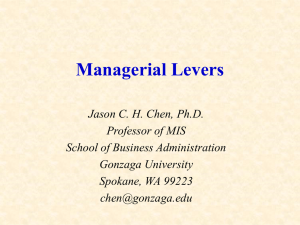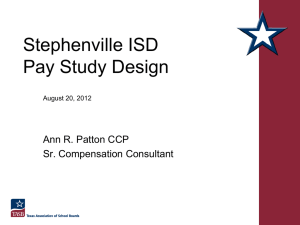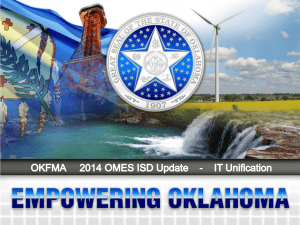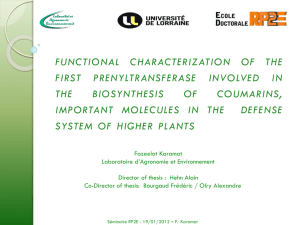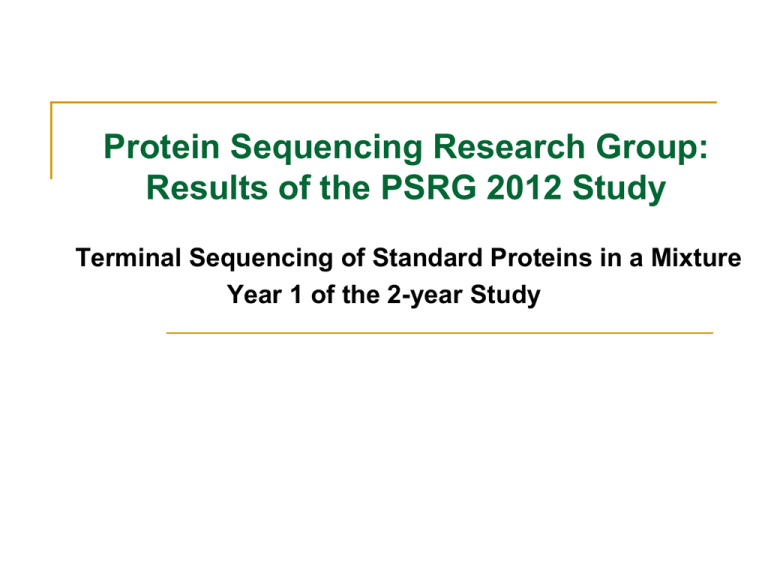
Protein Sequencing Research Group:
Results of the PSRG 2012 Study
Terminal Sequencing of Standard Proteins in a Mixture
Year 1 of the 2-year Study
Current PSRG Members
Henriette Remmer (Co-Chair)
Jim Walters (Co-Chair)
Robert English*
Pegah Jalili*
Viswanatham Katta
Kwasi Mawuenyega
Detlev Suckau
Bosong Xiang
Jack Simpson (EB liaison)
* new members added in 2011
University of Michigan
Sigma-Aldrich
University of Texas Medical Branch
Sigma-Aldrich
Genentech, Inc
Washington University School of Medicine
Bruker Daltonics
Monsanto, Co.
United States Pharmacopeia
PSRG 2012/13 – Study Background and Design
Status of Terminal Sequencing :
In the midst of a technology transition from classical Edman sequencing to mass
spectrometry (MS) based sequencing
Both technique have varied strengths and weaknesses and both have a role in
biochemical research.
With a complimentary role realized, we attempt to push the capabilities of the various
sequencing techniques, namely terminal sequencing of proteins in mixture
Concept of the 2012 Study- Terminal Sequencing of Proteins in a Mixture:
Sequencing proteins in a mixture requires separation of proteins prior to analysis
Edman Sequencing : SDS-PAGE and electroblotting prior to analysis –
well established in most core facilities
MS based sequencing: LC separation necessary prior to analysisnot well established in most core facilities
=> PSRG designed a 2-year study
YEAR 1: Terminal sequencing and identification
of three separated standard proteins
YEAR 2: Same three proteins distributed, this time in mixture
PSRG 2012 Year 1: Study Objective
To obtain N-terminal sequence information on
three standard proteins supplied as
separated samples.
2011 Study Design – The Samples
Protein
Name
Amounts
Provided
(pmol)
N-terminally
blocked?
Fusion
Protein?
Comments
BSA
1mg
No
No
reference protein/
calibrant
Protein A
3x 100
Yes
Yes
Fusion protein with
blocked N-terminus
Endostatin
3x 100
No
No
Contains two Nterminal variants
Participants were asked to analyze the samples for terminal sequencing
using any technology available
Participants obtained all three proteins with ID in sufficient amounts to
sequence each protein utilizing all three technologies. Feasibility of
analysis had been validated by PSRG members.
Participants also filled out a survey, all responses were kept anonymously
Participation and Survey results
25 laboratories from 12 countries requested samples for Edman sequencing and
most of the labs (23) also for MS sequencing.
14 of the 25 participating laboratories (56%) completed the survey.
7 of the 14 labs utilized Edman sequencing , 6 top-down MS and 6 bottom-up MS.
Out of 14 respondents,
9 labs analyzed the reference protein BSA, 8 correctly determined the N-terminus
13 labs analyzed Protein A , 5 correctly determined the N-terminus
14 labs analyzed Endostatin, 12 labs correctly determined the N-terminus , only 7
identified the presence of the second N-terminus
Participation and Survey Results
15
Number of
Respondents
Correctly
determined the Nterminus
Unable to determine
the N-terminus
10
5
0
BSA
Protein A
Endostatin
Survey Response Results
What types of analyses did you perform on the sample?
60.0%
50.0%
40.0%
30.0%
20.0%
10.0%
0.0%
Purification and separation method before analysis
N-Terminal Techniques:
Edman Degradation
Edman Workflows
PSRG 2012 Samples
Used sample as
Provided
(5)
Shimadzu
PPSQ-33A
SDS PAGE –
blotting on PVDF
(2)
blotting on PVDF
(1)
ABI Procise
4 - 494 HT’s
1 – 492 cLC
2 - 494 cLC
C10
Edman sequencing Protein A
PROTEIN A- FUSION PROTEIN- N-TERMINUS BLOCKED
De-blocking
(PGAP)
100 pmol
Polybrene-precycled
glass fiber filters
ABI Procise
Biosystems
Model
494HT
Sequence 1
C10
MMet
L
R
P
V
E
T
P
-
L
R
P
V
E
T
P
Edman sequencing of Endostatin
H2O with
0.1 % TFA
blotting on PVDF
A00
Shimadzu
PPSQ-33A
Initial Yield: 36.95 %
Repetitive Yield: 84.98 %
Probability 1: position 4 Proline to Arginine
Probability 2: position 7 Histine to Glutamine
Edman sequencing of Endostatin
A00
Sequence 1
D
F
Q
P
V
L
H
L
V
A
L
N
S
P
L
A00/Vaiants 1
D
F
Q
P
V
L
H
L
V
A
L
N
S
P
L
Sequence 2
H
S
H
R
D
F
Q
P
V
L
H
L
V
A
L
A00/Variant 2
Information about the
sequence:
SwissProt output
Sequence Verification:
with Blast P
R
Q
Summary of N-terminal sequencing result
Sample Description
Lab ID
BSA
Y20
D T H K S E I A H R F K D L G E E H F K G L V L I A F S Q Y L Q Q X P F D E H V K L V N
C10
D T H K S E I A H R F K D L G E E H F K G L V L I A F S Q Y
N32
D T H K S E I A H R F K D L G E E H F K G L V L I
A00
D T H K S E I A H R F K D L G E E H F K G L V L I A F S Q Y
Protein A
Y20
Y20
C10
Endostatin Seq. 1
Endostatin Seq. 2
Amino acid sequence
F L R P V E T P T R E I K K L D G L A Q H D E A Q Q N A F Y Q V L N M P N
M F L R P V E T P T
L R P V E T P T R E I K K L D G L A Q H D E A Q Q N A F Y Q V L
N32
X L R P V E T P X R E I K K L
A00
M L R P V E T P T R E I K K L D G L
S10
X L R P V E T P T R E I K K L D G L A Q H D E A Q Q N A
V00
F L R P V E T P T R E I K K L D G L A Q H D E A Q Q N A F Y Q V L N M P N
Y20
D F Q P V L H L V A L N S P L S G G M R G I R G A D F Q X F Q Q A
C10
D F Q P V L H L V A L N S P L S G G M R G I R G A D F Q C F Q Q A R
E20
D F Q P V L H L V A L N S P L S G G M R G I R G A D F Q C F Q Q A R A V G L A G T
N32
D F Q P V L H L V A L N S P L S G G M R G I
A00
D F Q P V L H L V A L N S P L
S10
D F Q P V L H L V A L N S P L S G G M RG
Y20
H S H R D F Q P
C10
H S H R D F Q P X L H X X A L N X X X S G G M
E20
H S H R D F Q P V L H L V A L N S P L S G G M R G I R G A D F Q C
N32
H S H R D F Q P V X H X V A L N S
PSRG 2011 Edman Conclusions & Observations
Edman sequencing allows for direct determination of
the protein’s N-terminal sequence.
All lab returned N-terminal data which correlate well with the published
protein sequences
It can produce the data with and without separation (SDS PAGE and
chromatography)
No C-terminal data was produced with Edman.
If the protein N-terminally blocked, the reaction will not proceed for most
but not all modifications.
The reagents for Edman sequencing are very expensive
N-Terminal Techniques Overview:
MS Techniques
Mass Spectrometry Methods Used
Top-Down Sequencing (no digests)
ISD, T³:
AB Sciex 4800 MALDI-TOF/TOF
MS, ISD, T³:
Bruker Ultraflex MALDI-TOF/TOF
MS, ETD,CID:
Bruker maXis 4G UHR-QTOF
Only Top-Down N-term results were returned.
Some participants used Bottom-Up MS as validation step
Bottom-Up MS/MS (digests)
MALDI-TOF/TOFs: AB/Bruker
ESI-Orbitrap:
Thermo
Top-Down Experimental
Sample
Separation
Top-Down Instrumentation
ISD
ISD/T³
HPLC
0.1% TFA
MeOH/H2O/HOAc
6M GndHCl
Various organic/H2O/acid
Direct infusion
As provided
Bruker Ultraflex
Bruker UltrafleXtreme
Bruker Autoflex
speed
ISD/T³
Agilent 1200
Triversa
Nanomate
AB Sciex 4800
ETD
CID
Bruker MaXis 4G
Software used for MS Top-Down Analysis
BioTools 3.2: Sequence-tags, automatic de-novo
sequencing, trigger Mascot TD searching, result
visualization, terminal assignments, TD report generation
(Bruker)
Mascot 2.3: TD and BU Database searches
(Matrix Science)
BLAST/MS-BLAST: Protein identification based on
sequence tags
(NIH, Harvard/EMBL)
ISDetect: Sequence-tags, semi-automatic de-novo
sequencing, result visualization
(Genentech, Y Gan et al, in prep. )
The Top-Down MS Standard Analysis Strategies
MW Determination: Check Sample Quality + Final QC
ETD/ISD: obtain internal sequence Tags
D T H K S E I A H R F K D L G E E H F K G L V L I A F S Q Y L QQ C P
ID Protein: e.g. Mascot search
Extend Sequence towards N-terminus (and C-term alike)
Compare with obtained protein sequences incl. PTMs)
T³-Sequencing, i.e. MS/MS analysis of MALDI-ISD fragments
Edman sequencing
D T H K S E I A H R F K D L G E E H F K G L V L I A F S Q Y L QQ C P
Problems: unknown terminal modifications (Sample B),
fusion proteins (Sample B), ragged ends (Sample C)
BSA ISD Spectrum in DAN matrix
good calibrant for ISD Spectra
PSRG123
Sample A: BSA, ISD+Edman
following the basic strategy
C10
BSA sequence Accession number: AAI02743
c-ions in the MALDI-ISD spectrum revealed the sequence from
Arg10 -Tyr30.
Edman sequencing provided Asp1 to Gly15
Data from the orthogonal methods were put together to obtain 30
residues of BSA sequence.
FINAL SEQUENCE OBTAINED FOR BSA:
1
10
20
30
40
DTHKSEIAH RFKDLGEEHF KGLVLIAFSQ YLQQCPFDEH VKLVNELTEF…
Coverage by Edman
Coverage by MALDI-ISD
Coverage by both
Sample B Endostatin (donated by Sigma)
issues: ragged N-term, C-term loss of K
C-term K excised
added
C-term K excised
Endostatin
Annotated ISD Spectrum from on/off gradient
Interfering
component
L36
Endostatin
L36
HPLC chromatogram, separation of two variant, ISD of F1, F2 not assigned
The recovery from the endostation sample
might be lower than 100 pmol
100 pmol
Myoglobin
standard
F2
F1
LC-separation detected the protein heterogeneity, removed polymeric contamination
but reduced the sample amount and readout length
UHR-QTOF MS analysis of Endostatin:
Z10
2 Components
Intens.
x105
+MS,
1496.8469
1.0
1390.0011
0.8
1621.4171
0.6
1945.6003
1768.8184
0.4
1297.3352
1221.9913
0.2
0.0
1200
1400
1600
1800
2000
m/z
In contrast to MALDI-ISD, the QTOF-ETD analysis takes place after precursor ion selection
ETD Analysis of Endostatin, First Precursor:
Mascot Database Search Result
Simplest Use of Top-Down Data: Mascot Search
Z10
TDS Analysis of Endostatin, First Precursor:
Deconvoluted and Annotated ETD Spectrum
c2
c9
Z10
c 26
TDS Analysis of Endostatin, First Precursor:
Z10
Mass Accuracy of intact Protein
Measured Monoisotopic mass
Intens. Monoisotopic mass
Theoretical
5
19433.8783
19433.8151
x10
4
Mass error
3.2 ppm
Measured (black) Spectrum
Simulated (red) Spectrum
+MS, 0.5-20.4min, Deconvoluted (MaxEnt)
C866H1340N250O250S6, 19433.8151
1+
19444.8432
1+
19443.8408
1+
19446.8479
1+
19442.8383
1+
19447.8502
3
1+
19448.8526
1+
19441.8359
1+
19449.8548
2
1+
19440.8334
1+
19450.8571
1+
19439.8308
1+
19451.8594
1
1+
19452.8616
1+
19438.8282
1+
19453.8638
1+
19437.8256
1+
19436.8229
0
19436
19438
19440
19442
19444
19446
19448
19450
Precision MW allows to confirm proper N-term and C-term loss of Lysin
19452
19454 m/z
Endostatin: TDS Sequence 1
PSRG123
Endostatin: TDS Sequence 2
PSRG123
If ISD spectral quality is good, both sequences can be directly read and N- and C-termini
can be assigned from THE SAME SPECTRUM
Rec. Protein A (donated by Repligen)
Issues: N-term methylation, fusion site after residue 18
E.coli b-Glucuronidase
SPA_STAAU C-term sequence does not match intact MW
(nice challenge for Top-Down MS in the Future..)
%
40
30
0
2340.0
20
2875.2
3512. 514
10
3410.4
Mass (m/z)
3945.6
1756. 740
1769.6
4480.8
2059.8
100
2308. 141
A
2295. 997
2180. 096
2109. 059
2070. 882
2041. 839
2029. 874
2013. 854
1995. 994
1938. 978
1912. 813
1885. 778
1835. 913
1823. 966
1809. 931
1797. 780
1774. 780
I/L
4848. 976
1710. 888
1740. 760
1724. 774
G
4705. 008
1641. 726
1626. 733
1656. 733
manual sequence generation
1056. 538
4700 Reflector Spec #1 MC=>BC=>SM5[BP = 1056.5, 9640]
4606. 874
1479.4
D
4535. 005
1582. 809
1599. 729
I/L
4420. 955
1547. 683
1568. 760
K/Q
4308. 395
1470. 682
1485. 682
K/Q
3965. 857
1189.2
1454. 726
1440. 693
1419. 635
1401. 607
1383. 634
1370. 625
1357. 615
1341. 656
1327. 631
1304. 601
I/L
3851. 577
A K/Q
K/Q
1289. 606
1260. 549
1245. 541
1228. 526
1215. 572
1203. 549
1188. 525
1161. 564
1137. 325
1120. 359
1105. 392
1087. 428
1073. 412
1058. 383
1042. 506
1027. 501
1013. 273
998. 272
955. 500
E
3348. 530
E
3201. 401
70
3130. 361
971. 467
984. 284
50
1212. 624
934. 331
R
3016. 333
0
899.0
2888. 299
60
957. 500
60
4193. 676
50
H
T
2760. 251
80
2689. 229
90
919. 333
70
2560. 194
10
944. 343
I nt ensi t y
80
2445. 186
20
2410. 025
30
903. 327
40
926. 387
%
100
3738. 646
I nt ensi t y
ISD Spectrum Protein A (DAN)
E20
90
9.6E+3
K/Q
2350.0
4700 Reflector Spec #1 MC=>BC=>SM5[BP = 1056.5, 9640]
Mass (m/z)
789.6
D
5016.0
Protein A Identification
E20
ISD spectrum for Samples #2 (Protein A) was manually interpreted by sequential subtraction of ions
Resultant sequence:
TRE[IL][KQ][KQ][IL]DG[IL]A[KQ]
was Blasted against the Dayhoff public database (below)
Only two sequences matched.
Homology searching of the N-term Tag provided a) b-Glucuronidase, b) its N-terminally
extended sequence, c) mass offset indicates N-term Methylation
Protein A MS/MS
ISD c-ion m/z 1056.538
T³-sequence analysis of c9 confirms N-term methylation
E20
Protein A
L36
MS/MS of N-terminal tryptic fragment
M
Ion
a
b
a-17
b-17
y
i
L
R P V
E
T
P
T
R
1 2 3 4 5 6 7 8 9 10 1
M* L R P V E T P T R
M* L R P V E T P T R
M* L R P V E T P T R
M* L R P V E T P T R
M* L R P V E T P T R
M* L R P V E T P T R
10 9 8 7 6 5 4 3 2 1
Met
Leu
2
118.068
146.063
101.042
129.037
175.119
118.068
Arg
Arg
3
231.153
259.147
214.126
242.121
276.167
86.096
Thr
Pro
4
387.254
415.249
370.227
398.222
373.219
129.113
Pro
Val
5
484.306
512.301
467.280
495.275
474.267
70.065
Thr
Glu
6
583.375
611.370
566.348
594.343
603.310
72.081
Glu
Thr
7
712.417
740.412
695.391
723.386
702.378
102.055
Val
Pro
8
813.465
841.460
796.439
824.433
799.431
74.060
Pro
Thr
9
910.518
938.513
893.491
921.486
955.532
70.065
Arg
Arg
10
1011.566
1039.560
994.539
1022.534
1068.616
74.060
Leu
Validation of assigned N-term methylation and glucuronidase sequence by Bottom-Up
LC-MALDI-TOF/TOF analysis
1167.667
1195.662
1150.640
1178.635
1213.672
129.113
Met
Protein A
L36
Annotated ISD spectrum
The N-terminal sequence is b-gluronidase fused with protein A. The N-terminal Methionine is
methylated. The N-terminal aminoacids not confirmed by ISD was confirmed by MS/MS of
the N-terminal tryptic fragment
Results from MS Analyses
Please look at poster ##?? For more details
Lessons to be Learned from this Years Study
Mass Spec Lessons..
1. Top-Down with ETD or ISD provides reliable N-term sequences
2. Top-Down CID was most easily misinterpreted
3. Edman and Top-Down Complement each other very well: Edman for the first
~10 residues, Top-Down for the inexpensive extension of calls (e.g. through
the fusion site of Protein A)
4. Validation of the N-term by either T³-sequencing or Bottom-Up works as well
5. Efficient use of Top-Down MS requires good software support
6. Bottom-Up was great to confirm N-term results but not to generate them
7. Use of protein HPLC resulted in shortened readouts
8. Protein A Successful analysis of the fusion required high experience
9. Endostatin ragged N-termini were recognized by those that determined the
intact molecular weight(s) , detected heterogeneity by HPLC or Edman
10. Top-Down by ETD or ISD permitted the detection of the C-terminal removal
of Lysine, intact MW determination allowed to validate the finding
Next years ABRF-PSRG2013 study
what's going to happen?
Most likely, the same proteins will be provided again!
But: provided as a stew in a single pot!
Task: Isolate/separate them from the mixture
Problem: SDS-PAGE works well for Edman, but it is
difficult to extract intact proteins
Hints:
Protein LC needs to be established, to get to the next level!
Always try to get intact MW information!
Use high sample amounts as you loose a lot during LC
The ABRF-PSRG Acknowledges the following
Support
Recombinant Protein A was obtained as donation from
RepliGen (Waltham, MA)
Endostatin was obtained as donation from SIGMAALDRICH (St Louis, MO)
Steve Smith (University of Texas Medical Branch) and
Larry Dangott (Texas A&M University) for Edman
sequencing to provide reference data for this study.
End
Following slides are bonus material
In-Source Decay (MALDI-ISD)
MALDI-ISD
•
•
•
•
•
“pseudo-MS/MS” technique, no precursor selection
ISD of protein in the MALDI plume at <nsec timescale (similar to ETD)
Fragmentation due to radical transfer from matrix to analyte (Takayama, 2001)
a,c- ions: N-terminus; y, z+2-ions: C-terminus – simultaneous sequencing
TOF/TOF allows for T³-sequencing: MS/MS analysis of ISD fragments
MALDI-ISD and T³-Sequencing
Suckau & Resemann (2003) Anal Chem 75
ESI-ETD (Electron Transfer Dissociation)
CID
•
•
•
•
Collision with inert gas
protein is internally heated globally
it fragments in statistic process
weak bond cleavages
ETD
•
•
•
•
•
Collision with electron donating gas
perturbates electronic structure locally
resulting in local bond cleavages
ETD fragments all bond (except Pro)
for top down MS/MS of intact proteins
with precursor ion selection
ETD Measurement Cycle on QTOF
1. Precursor Ion Accumulation
2. Electron Transfer Reagent Addition
3. ETD Reaction
4. Fragment Ion Transfer and Detection
10 kHz
Reaction Cell
n-CI Source
Tsybin et al. (2011) Anal Chem 83:8919
%
40
30
20
0
2245
10
2756
3267
Mass (m/z)
3620. 403
3777. 469
3778
3850. 483
4289
1979.8
D
2206. 957
2190. 964
2178. 956
2149. 937
R
4671. 200
2077. 880
2065. 896
2015. 827
initial manual interpretation
1364. 645
4700 Reflector Spec #1 MC[BP = 1364.6, 6319]
4600. 930
1924. 835
1936. 783
1993. 845
1893. 830
1908. 856
M
4444. 805
1709.6
4296. 463
4195. 564
1862. 823
1881. 833
1866. 837
1805. 811
1748. 792
1661. 772
G
4138. 845
4104. 137
1828. 800
1792. 781
1779. 805
1767. 799
1752. 791
1683. 752
1666. 741
1654. 734
1627. 730
1595. 709
1583. 707
1548. 701
1505. 684
1484. 663
1471. 685
1452. 631
G
4069. 048
3954. 714
1408. 621
1427. 620
S
3897. 704
1439.4
3799. 517
1250. 611
1386. 629
1371. 590
1358. 589
1313. 632
1295. 595
1272. 594
1248. 550
1234. 548
1202. 542
1171. 544
I/L
3727. 686
3694. 580
3649. 499
1137. 542
1155. 578
N
3571. 589
3501. 516
3403. 354
K/Q
3372. 525
1169.2
3244. 298
F
3097. 252
1057. 339
1121. 476
1102. 528
1089. 329
1073. 338
1060. 379
1034. 432
1014. 250
998. 242
981. 249
934. 298
919. 302
100
3334. 382
50
967. 460
949. 283
937. 306
I/L
2994. 245
70
2907. 070
0
899.0
2866. 211
60
2719. 152
K/Q
2604. 136
N
2533. 111
80
2511. 039
90
2476. 098
100
2380. 018
10
922. 312
50
2320. 021
30
903. 292
60
926. 314
I nt ensi t y
70
2334. 990
20
911. 340
%
40
2265. 994
I nt ensi t y
ISD Endostatin (DAN):
E20
90
6318.9
80
G
Mass (m/z)
2250.0
4700 Reflector Spec #1 MC[BP = 1364.6, 6319]
1505.5
C
4800
Data base search for
[IL]SGGMRGNR[KQ]DF[KQ]CF
E20
Sequence from spectrum was found beginning at 1548.694, so we know there are a
handful of residues preceding this seq
Excerpt from
COIA1_HUMAN
Excerpt from
COIA1_MOUSE
Differences between human and mouse can be seen in the -2 position from the start of ISD
sequence (ie. LNSPL in human and LNTPL in mouse)
10
0
9.0
72. 11
197. 12
295.4
010212_B23_10pmol_Endostatin_MSMS_2kV_1364.65
b5
581.8
Mass (m/z)
950. 37
y7
868.2
1049. 43
y9
1154.6
1356. 67
b10
1371. 48
110. 09
1364. 60
100
1377. 35
1347. 76
1333. 92
1317. 66
b9
1234. 51
b8
1120. 46
b7
974. 48
y6
837. 30
665. 30
b3
778. 36
648. 31
b4
587. 19
534. 24
488. 15
391. 13
b2
442. 21
364. 22
350. 14
326. 11
310. 17
280. 11
263. 09
251. 13
235. 10
223. 14
209. 10
183. 12
169. 13
155. 10
112. 11
70. 10
101. 09
40
115. 11
86. 12
P
129. 11
20
87. 11
30
84. 09
50
100. 11
60
60. 09
23. 03
I nt ensi t y
70
44. 09
30. 07
%
To confirm N-terminus not covered in the ISD
spectrum, MS/MS was performed on m/z1364.6
E20
4700 MS/MS Precursor 1364.65 Spec #1 MC=>BC=>NF0.7[BP = 1364.6, 360]
360.4
90
80
Immonium Ions
K/Q
I/L
H
1441.0
Determination of Endostatin N-termini by E20
Edman degradation.
-
Major sequence matches CO1A1_HUMAN at position 1576.
A second sequence was found from position 1572.
Both sequences concur with the ISD findings.
Edman sequencing detected the ragged N-term, ISD confirmed and extended it
Largely manual analysis of ISD spectra made it difficult to extract full information
2012/2013 PSRG: Timeline of the 2-year study
May ‘11
Data analysis
Jun ‘12
May ‘12
ABRF
2013
Feb ‘13
Oct ‘12
Mar ‘12
Data analysis
Samples sent
Year 1 (2012) to participants
Study
announcement
Discussed ideas for 2012 study.
Agreement upon a study design
Deadline for returning
data
Jan
‘12
Extended
deadline
for returning
data
Sep
‘11
Feb
‘11
ABRF 2011
Oct ‘11
Aug ‘11
Settled on the 3 standard proteins for
distribution as separated proteinsi n year 1 of ABRF
2012
the study
Distribution of proteins in
mixture for year 2 of the
Year 2 (2013) study
Study
announcement
Comments……
un-reproducible recovery from the tube for Endostatin is a
problem if one wants to optimize the setting or try to
reproduce the data…..
Thanks! PSRG. It was fun. Unelss I've missed something, the
availability of the proteins in the public domain made this an
easy project. Sample quality was very good!
I thought the fusion Protein A solution was blocked? I
obtained sequence matches to the protein B-Glucuronidase,
either B-Glucuronidase is fused to Protein A and you were not
successful blocking the protein or B-Glucuronidase is a
contaminant……
It was very costly study for an Edman lab, (reagents).



